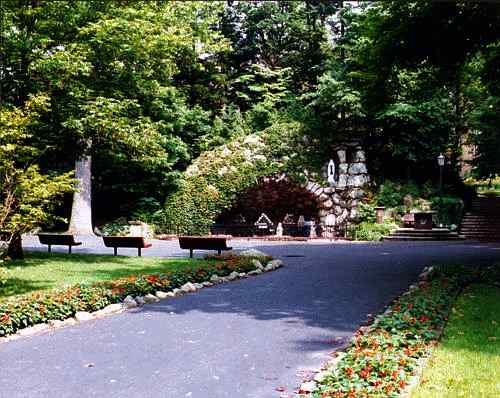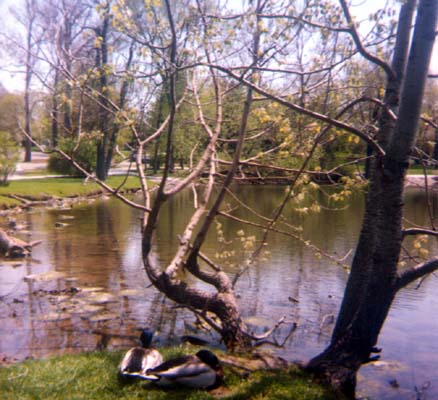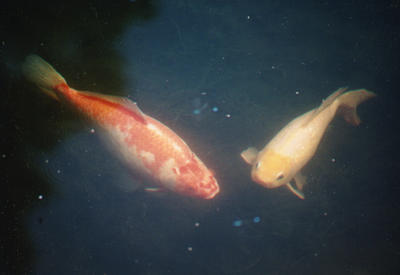
A Cave of Candles / by Dorothy V. Corson

Chapter 1

My First Glimpse of the Notre Dame Grotto
As the winter of my father's death turned to Spring and then to early summer, the memory of that fanciful February evening at the St. Stanislaus Grotto kept returning, nudging me to visit the University of Notre Dame to see for myself the Grotto that had inspired the one my father built for Father Jan (Rev. Sigmund A. Jankowski, C.S.C., pastor 1946-1968, St. Stanislaus Church, South Bend, Indiana).
Although I was born in South Bend and lived a mile from the campus, I had never visited it before. And so, in the summer of 1964, six months after my father's death and seven years before I met Father Jan, I found myself walking hand-in-hand with our six year old son delighting in its pastoral surroundings, drawn there by the memory of my father and the picture in my mind of that glowing cave of candles on that frosty, moonlit night.
The activity and the ducks at the lake drew us there first to empty the bags of bread we'd brought with us. The lake rippled and glittered in the noonday sun sparking diamond "sun dollars" in the distance as only that certain time of day can do. Greg was enchanted by the ducks and delighted in feeding the many goldfish of all different sizes that came to the water's edge to feed on the crumbs. The gold of the Dome seemed to be reflected in the golden fish, some nearly a foot long, swimming in the waters of St. Mary's Lake -- a sight I miss now, these many years past, when all the goldfish are gone.
Soon Greg spotted the Grotto tucked into the landscape across the way. I had told him that people prayed there, how they lit candles in memory of loved ones, and for special wishes or favors they wished granted. Having seen the one his grandfather had built, he was as eager as I was to see it up close.
This peaceful wayside shrine, located at the heart of Notre Dame's picturesque campus, is nestled in a gentle hillside among the trees in the shadow of the Golden Dome and the spire of the Basilica of the Sacred Heart.(4) A feeling of warmth and welcome -- a spiritual resonance -- envelops this lovely wooded dell that no camera can adequately capture. It's as if it were filled with all the hopes and dreams of everyone who has ever paused there in prayerful petition over the past 100 years. The scenic charm of its lakeside setting beckons from afar. Its soft candleglow invites a closer inspection.
As we strolled down the flower-lined path leading to the Grotto, Greg spied a quarter almost covered in dirt. He looked up at me for an okay to pick it up; I nodded and he smiled and tucked it away in his pocket. As we drew closer to the Grotto, he asked if he might light a candle for his grandfather. I told him it was customary to leave an offering and he immediately held up his quarter. Pleased that he had offered his "find," I added to it and watched as he carefully lit a candle and just as carefully chose a special place for it among the others.
Neither of us has forgotten the memory of that special moment we shared together. Most especially myself, for it was at that moment that a second wish -- to know more about the history of the Notre Dame Grotto -- was added to the one I'd left at St. Stan's Grotto. My desire to know the story and the people behind it has intrigued me ever since.
Though the first wish -- the plaque at St. Stanislaus Grotto -- was granted seven years later, the second one continued to tug at my consciousness over the years and just wouldn't let go. Unbeknown to me at the time, that first visit to the Notre Dame Grotto was destined to become just the beginning of a series of events that have changed the direction of my life and are still affecting it, even now, 30 years later. My son and I often returned to the campus to feed the ducks and visit the Grotto, always uplifted by such peace and tranquility just a short bicycle ride from home.

In the years that followed that first visit, I asked almost every new priest and nun I encountered on campus about the Grotto always receiving the same answers. The Grotto was attributed to Sorin and financed by Father Thomas Carroll of Oil City, PA, as the plaque on the Grotto attests. No additional information was forthcoming.
Then one day in 1978, fourteen years after my first visit to the Grotto, I had an encouraging conversation with a friend on campus, Brother James Lakofka, C.S.C. who dispenses Lourdes water and fulfills letter requests to light candles from people living too far away to visit the campus. Throughout the month he lights candles for former students, mothers of students, and the wives of deceased professors whose favorite spot on campus was the Notre Dame Grotto.
Brother James very kindly offered to send me whatever articles and literature he had concerning the Grotto. A large envelope arrived in the mail the next day. I opened it with anticipation, only to find the same brief information repeated in a number of different articles. It was as though every writer had copied what had been written previously. From that time on, I pretty much gave up asking, but I never stopped wondering about it.
I have always loved a mystery, so it was not unusual for me, knowing the background of the St. Stan's Grotto, to wonder about the one at Notre Dame. The stories behind the three favors granted plaques at the Grotto also sparked my interest, especially the one for February 26, 1918 with the two sets of initials. Was it put there by a young engaged couple in gratitude for his surviving World War I? I often wondered if others wondered too, where the rocks came from, who shaped them into the Grotto and who set the dream in motion.
Looking back on it now, I am convinced that an unrelenting desire to solve those mysteries was instilled in me on that lovely summer day in 1964 when I lit a candle of hope and left my second wish at the Notre Dame Grotto -- a wish that to my amazement was to be granted 27 years later.

In choosing the photographs for this story, I received the happy news that goldfish still live in St. Mary's Lake. Bob Ringel took this photograph of these now elusive goldfish swimming in the waters between the island and Carroll Hall. He said he has also spotted the smaller golden ones there and near the Fatima Retreat Center and a very large bright red and orange one nearby.